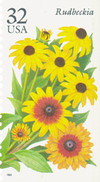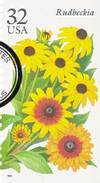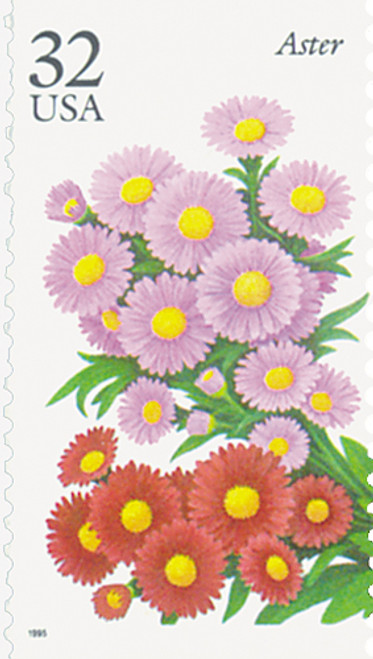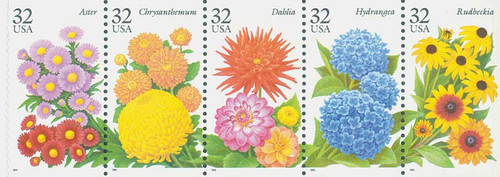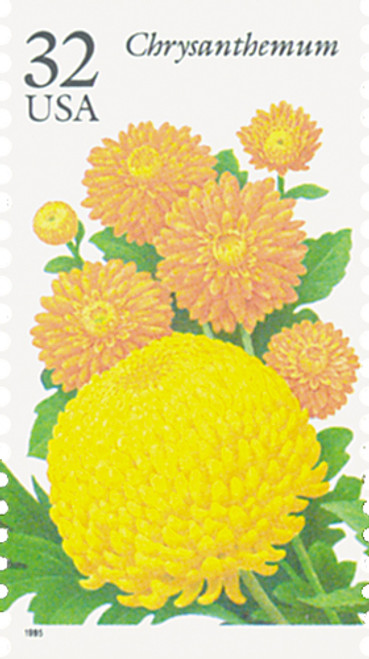
# 2997 - 1995 32c Fall Garden Flowers: Rudbeckia
U.S. #2997
1995 Rudbeckia
Fall Garden Flowers
- Third issue in the Garden Flowers Series
Stamp Category: Commemorative
Series: Garden Flowers
Value: 32¢ First-Class postage rate
First Day of Issue: September 19, 1995
First Day City(s): Encinitas, California
Quantity Issued (if known): 200,000,000
Printed by: Bureau of Printing and Engraving
Printing Method: Offset (flower images) Intaglio (type)
Format: Booklet of 20 stamps. Four booklet panes of 5 stamp strips.
Perforations: 10.9
Why the stamp was issued: This stamp was issued as part of the third installment of the Garden Flower Series. This stamp fulfilled the then-current first-class postage rate of 32¢.
First Day City: The ceremony was held at the Quail Botanical Gardens in Encinitas, California.
About the Garden Flowers Series: On May 15, 1993, the USPS issued the first installment in the Garden Flower Series, which would honor flowers that bloom in each of the four seasons.
This series was born out of the 1992 Wildflowers issue. That project had begun when the USPS asked an artist to produce color sketches of a group of garden flowers. Instead, the artist gave the USPS illustrations of wildflowers. The USPS liked them so much, it decided to create a 50-stamp pane, showing wildflowers that can be found in each state.
The USPS still liked the garden flowers idea. Part of the push behind these stamps had come from the sale of stamps in supermarkets and other retailers. People said they wanted “bright, pretty American stamps.” The USPS decided flower booklets would please the public. It ran TV commercials and full-page advertisements in stamp publications announcing “The flowers are in bloom at your post office. Buy them while they last!” and “Pick up a bunch.” The Garden Flowers booklet was the first to be produced on the new Goebel booklet machine, which was the first to print multicolor covers.
The stamps were issued on May 15, 1993, in Spokane, Washington at the 55th annual Spokane Lilac Festival and International Lilac Society Convention. Though not announced at the time, these stamps were to be the first in a new series of seasonal flower booklets.
The second booklet in the series was issued on April 28, 1994, at the Greater Cincinnati, Ohio, Flower and Garden Show. It featured summer garden flowers.
The third booklet in the series was issued on September 19, 1995, at the Quail Botanical Gardens in Encinitas, California. This booklet featured fall blooms.
The final booklet in the series was issued on January 19, 1996, in Kennett Square, Pennsylvania. The flowers selected for these stamps are the hardiest plants that grow anywhere in the country that experiences winter weather.
History the stamp represents:
Rudbeckia
Rudbeckias are those beloved flowers with yellow petals radiating from central black disks – known as “Black-eyed Susans” to most people. Native to North America, rudbeckias brighten our roadways, meadows, and mountainsides as well as cultivated gardens. Rudbeckias were named to honor the Swedish physician and botanist Rudbeck, founder of the botanical garden of Uppsala. Rudbeck’s assistant was Linneaus, the man responsible for our classification system of plants and animals.
Like all members of the compositae family, each bloom is not one, but many flowers. The dark central disk is a flower as is each petal that radiates from it.
Flowers have long been cultivated for food, medicine, fragrance, and dyes. In Europe, life was harsh during the Middle Ages, with everyone focusing on spiritual rather than worldly matters. The Renaissance changed all that and people began studying man and the world around them. Horticulture was one of many scientific endeavors in which the nobility actively participated. Because of those efforts, the world enjoys more varieties of flowers than ever before. Today, ordinary people can cultivate flowers for pleasure – once an exclusive privilege of royalty and wealth.
U.S. #2997
1995 Rudbeckia
Fall Garden Flowers
- Third issue in the Garden Flowers Series
Stamp Category: Commemorative
Series: Garden Flowers
Value: 32¢ First-Class postage rate
First Day of Issue: September 19, 1995
First Day City(s): Encinitas, California
Quantity Issued (if known): 200,000,000
Printed by: Bureau of Printing and Engraving
Printing Method: Offset (flower images) Intaglio (type)
Format: Booklet of 20 stamps. Four booklet panes of 5 stamp strips.
Perforations: 10.9
Why the stamp was issued: This stamp was issued as part of the third installment of the Garden Flower Series. This stamp fulfilled the then-current first-class postage rate of 32¢.
First Day City: The ceremony was held at the Quail Botanical Gardens in Encinitas, California.
About the Garden Flowers Series: On May 15, 1993, the USPS issued the first installment in the Garden Flower Series, which would honor flowers that bloom in each of the four seasons.
This series was born out of the 1992 Wildflowers issue. That project had begun when the USPS asked an artist to produce color sketches of a group of garden flowers. Instead, the artist gave the USPS illustrations of wildflowers. The USPS liked them so much, it decided to create a 50-stamp pane, showing wildflowers that can be found in each state.
The USPS still liked the garden flowers idea. Part of the push behind these stamps had come from the sale of stamps in supermarkets and other retailers. People said they wanted “bright, pretty American stamps.” The USPS decided flower booklets would please the public. It ran TV commercials and full-page advertisements in stamp publications announcing “The flowers are in bloom at your post office. Buy them while they last!” and “Pick up a bunch.” The Garden Flowers booklet was the first to be produced on the new Goebel booklet machine, which was the first to print multicolor covers.
The stamps were issued on May 15, 1993, in Spokane, Washington at the 55th annual Spokane Lilac Festival and International Lilac Society Convention. Though not announced at the time, these stamps were to be the first in a new series of seasonal flower booklets.
The second booklet in the series was issued on April 28, 1994, at the Greater Cincinnati, Ohio, Flower and Garden Show. It featured summer garden flowers.
The third booklet in the series was issued on September 19, 1995, at the Quail Botanical Gardens in Encinitas, California. This booklet featured fall blooms.
The final booklet in the series was issued on January 19, 1996, in Kennett Square, Pennsylvania. The flowers selected for these stamps are the hardiest plants that grow anywhere in the country that experiences winter weather.
History the stamp represents:
Rudbeckia
Rudbeckias are those beloved flowers with yellow petals radiating from central black disks – known as “Black-eyed Susans” to most people. Native to North America, rudbeckias brighten our roadways, meadows, and mountainsides as well as cultivated gardens. Rudbeckias were named to honor the Swedish physician and botanist Rudbeck, founder of the botanical garden of Uppsala. Rudbeck’s assistant was Linneaus, the man responsible for our classification system of plants and animals.
Like all members of the compositae family, each bloom is not one, but many flowers. The dark central disk is a flower as is each petal that radiates from it.
Flowers have long been cultivated for food, medicine, fragrance, and dyes. In Europe, life was harsh during the Middle Ages, with everyone focusing on spiritual rather than worldly matters. The Renaissance changed all that and people began studying man and the world around them. Horticulture was one of many scientific endeavors in which the nobility actively participated. Because of those efforts, the world enjoys more varieties of flowers than ever before. Today, ordinary people can cultivate flowers for pleasure – once an exclusive privilege of royalty and wealth.







